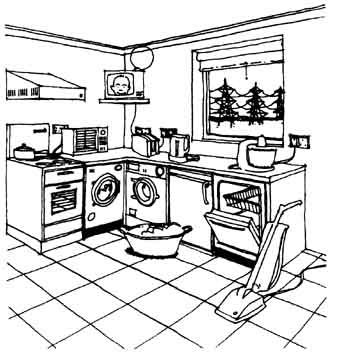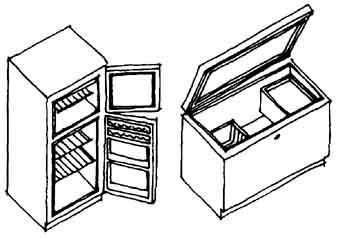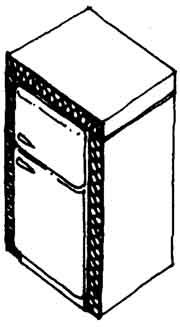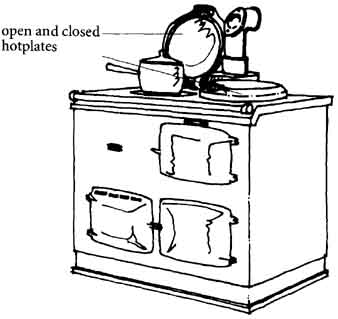There is an ever-increasing profusion of modern appliances, most of which are bought and sold with very little consciousness of the energy that they will consume. Our kitchens, in particular tend to be full of them. This consciousness is changing, however, helped along by the increasing number of “green consumer” publications. In some cases it is not so much a question of which appliance is the greenest choice, but whether such an appliance should be used in the first place.

Profusion of appliances
The last section dealt with lighting, an area in which we can make energy savings almost instantly by just exchanging light bulbs. This section demonstrates opportunities to conserve energy by improving the efficiency of some of the rest of our most energy-exploiting appliances. In many cases we will find that we can simplify our lives at the same time we are saving energy.
The following appliances, which assist us in the two main functions of feeding ourselves and maintaining our clothes, have been found to use the most energy:
• Refrigerators and freezers
• Kitchen stoves
• Washing machines
• Clothes dryers
• Dishwashers
CHOOSING AN ENERGY-EFFICIENT APPLIANCE
What are the key considerations you should take into account when you are thinking of buying one of these machines?
• Do you really need it in the first place? As we become aware of how much damage to the environment one of these machines can do in its lifetime, we should seriously consider whether we can do without certain appliances such as dishwashers.
• The energy source. For many of these machines there is no choice but electricity, but where there are alternatives these should be used if at all possible.
• Durability and ease of repair and maintenance. These are both crucial to the life expectancy of a machine. Very often this is a low priority for manufacturers compared to the initial cost and extra gimmicks.
• The energy in use. This is the most important consideration in the case of nearly all these machines, and one for which it should be possible to make comparisons before making a purchase. Manufacturers make a big deal about the initial capital cost, but much less concerning the actual cost in use.
• The energy required to manufacture and dispose of the appliance. There are no comparative figures available as yet, but this is clearly an area of increasing environmental importance.
Life-Cycle Energy Cost
The last two considerations can be brought together in the life-cycle energy cost for the appliance:
MANUFACTURING ENERGY + OPERATING ENERGY + DISPOSAL ENERGY = TOTAL LIFE-CYCLE ENERGY
More commonly this is expressed in monetary terms:
PURCHASE PRICE + LIFETIME ENERGY COST = LIFE-CYCLE COST
For example, if (a) you purchased a refrigerator for $400 and it costs $75 a year to run, or (b) you purchased a refrigerator for $560 and it costs $48 a year to run, and both machines have a life expectancy of 20 years then:
(a) $400 + ($75/yr. x 20 yrs.) = $1,840 (b) $560 + ($48/yr. x 20 yrs.) = $1,520
This simple calculation demonstrates that running costs in terms of energy and money are often an equally important consideration as the initial cost when it comes to buying a machine.
From an ecological perspective it would be more useful to be able to express all the costs, including the manufacturing costs, in terms of CO2 produced. This would be even more revealing than just comparing the capital cost with the running cost. If you go for an ecological choice and choose an appliance which will both last a long time and use minimal operating energy, you will almost certainly have to pay considerably more initially. However, this extra initial outlay could well be saved several times over during the life of the appliance. More importantly, you will be preventing many tons of CO2 from entering the atmosphere.
Reducing Our Energy Consumption by Careful Use
How should we view the machines we already own? Remember that we have a large influence on how much energy any appliance consumes, since it is how often and how efficiently we use a machine that probably has the greatest influence on its energy use. Undoubtedly there are different ways reductions can be achieved:
• Through choices relating to the overall use we make of high- energy-consuming appliances. For instance, how much raw food we eat rather than cooked food. Are we willing to think of our meals in terms of the energy consumed in their preparation?
• By using the heat being generated in our appliances, particularly in winter. This might affect the way we use appliances at different times of year.
• By coordinating the amount of cutlery and crockery we use with the most energy-efficient wash cycle of our dishwasher (find out what the cold rinse will achieve).
• By becoming aware of energy-wasting habits such as opening refrigerator and oven doors unnecessarily.
REFRIGERATING and FREEZING
In recent years, the efficiency of refrigerators has increased substantially.
Manufacturers have:
• Improved compressors and motors
• Introduced better door seals and compartmentization
• Increased insulation standards

A chest-type freezer (right) loses less heat when
opened than an upright freezer (left)
Even though there have been improvements, most fridges and freezers still operate a long way short of the maximum potential efficiency. Average running costs could be cut by half without serious difficulties, as we can see when we realize that the most efficient existing appliances are 50% more efficient than the average. Although a refrigerator uses a relatively small amount of power in use, it is the fact that it is working 24 hours a day, 365 days a year, often in the hottest room of the house, that causes it to be one of the highest energy users.
When choosing a new energy-saving refrigerator or freezer:
• Unless you use a large amount of frozen food, it makes the most sense to buy a combined refrigerator-freezer model. The most efficient place for the freezer compartment is at the top so that it can facilitate cooling below.
• If you do buy a separate freezer, then buy a well-insulated chest- type model which loses far less cold air when opened than an upright type.
• Work out carefully the optimum size you need. Both fridges and freezers operate best when they are at least three-quarters full.
• Automatic defrost models consume far more energy than the manual defrost models. This is because they contain heaters. The refrigerator is thus working against itself when defrosting and , if the refrigerator is being used inefficiently, the energy used can be increased by a further 50%.
• Find a refrigerator that is well insulated and look for energy-efficiency labels.
Energy Saving in Use
• Energy-saving microelectronics have recently been developed for refrigerators: they help to match the real load on the motor and save up to 20% on energy use. These electronics have been incorporated into a special plug called a “saver plug’ which is well worth installing.
• Locate a refrigerator or freezer away from sources of heat such as a stove or direct sunlight. If you have a refrigerator that is not well insulated, you can provide some extra insulation yourself on the top and sides.
• Check the temperatures inside the main refrigerator compartment and freezer. They should be between 3° to 5°C (37° to 41°F) and -18° to -15°C (0° to 5°F), respectively. If the temperature is outside these ranges, then energy is being wasted and the temperature control needs to be adjusted. Refrigerator and freezer thermometers are well worth buying and placing inside your refrigerator for the occasional check.

Extra insulation applied to refrigerator
• The back of a refrigerator is a notoriously difficult place to clean. However, the coils or fins tend to become sticky and dusty and this acts as an insulant, forcing the motor to work harder and waste more energy. To avoid this, clean them periodically with soap and water.
• If you have a manual or partial automatic defrosting model, defrost it regularly.
• Test the door seal and check that it is tight. This is equivalent to draft-proofing your fridge. If there is an air leak, it can not only waste energy unnecessarily, but will make more frequent defrosting necessary.
• Dispose of your refrigerator where the chlorofluorocarbons (CFCs) can be salvaged. Enquire at your city or town offices to find out where you can take it.
COOKING
In most Western cultures, food is typically cooked over a gas or electric burner or “hotplate’ in a gas or electric oven, or in a grill (usually gas- or charcoal-fired). These different ways of cooking food can also be combined, as they usually are, in a stove. This stove in turn can be either all electric, all gas, or (best of all) a gas appliance with electric ignition and energy-saving controls. There is yet another approach to cooking, in which space heating, water heating, and cooking are all combined in a single appliance such as an Aga, a logical integration descended from the old kitchen range. However, at present Agas lack the sophisticated electronic controls which could make them more energy-efficient.
The initial cost of electric stoves is less than that of gas stoves. However, tests carried out by Which? magazine have shown that electric stoves cost about three times as much to use as gas stoves. If we then compare the amount of CO produced, the cost difference could amount to four times as much! There are some electric stoves that are more efficient at transfer ring the energy to the pot or the food, such as microwave ovens or induction-loop cookers:
• Microwave ovens save up to a third of the energy when compared to a standard electric stove, making them a little more competitive. However, there are a number of factors involved in energy usage, such as the amount of food that is being cooked and the receptacle that is being used to hold the food.
• Induction-loop cookers save about 10% to 20% over conventional electric stoves. Such cookers are not widely available.
These savings are insufficient to overcome the ecological disadvantage of using electricity for cooking.
Choosing an Energy-Saving Stove
• In terms of the choice of fuel, natural gas is the obvious choice if you have a main supply to your home (if not, use propane or butane).
• Buy a gas stove that incorporates electronic controls to save energy and eliminate wasteful pilot lights.
• Stoves are not very efficient at cooking small quantities of food:
plan carefully how you intend to cook at the same time as buying your stove and pans. A microwave may sometimes be a more efficient answer if you are heating a lot of small portions. Having a range of pans of different sizes that are shaped correctly for the type of stove you have is also important.
Two final points should be made here that have a bearing on your consumption patterns, as well as on energy conservation:
• Remember that fresh, good-quality food is generally healthier if you eat it raw rather than cooked!
• Eat less! On average in Western society we eat far too much.

Like a masonry stove or wood cookstove, an Aga
burns solid fuel and takes some time to heat up, but it has a large
heat capacity Lids on top can be closed when not in use to insulate
the burners. Note: open and closed hotplates.
CLOTHES-WASHING
Washing machines use energy in two ways: to power the motor and to heat the water. Heating the water accounts for some 90% of the energy consumed. Most of the machines sold today heat the water within the machine, which means that the water is heated electrically—something to be avoided if possible. Therefore, if you heat your hot water by gas, it is worth buying a machine that can use hot water from this source even if it has an electric booster heater.
Features of Energy-Efficient Washing Machines
• Front loaders use about half the energy of top loaders because they use far less water.
• Machines that use gas-heated water are far more energy-efficient than those that heat water electrically.
• Machines with controls that allow the temperature and water level to be adjusted manually, or that have energy-saving settings will use no more hot or warm water than necessary for any particular load.
• Machines with a faster spin cycle save drying energy.
Energy Saving in Use
• Most laundry loads can be washed in cold or warm water. Use hot water only when essential.
• Put soap directly where it is required—on collars and cuffs for instance. Soaking clothes ahead of washing can mean a shorter or cooler wash.
• Follow the manufacturer’s instructions to get the most efficient use from your machine and acquaint yourself with each setting to understand which are the most energy-efficient. Always try and fill your machine to capacity.
Clothes are generally being washed more and more frequently due to the ease of using machines. It is worth remembering that, in the 18th century, some girls were actually sewn into their dresses, which were only undone for a bath at Christmas and Easter! While I am not suggesting that we return to this practice, the current habit of throwing all manner of clothes into the washing basket after wearing them only once is hardly sustainable.
CLOTHES-DRYING
Using an electric tumble dryer is not an ecological way of drying your clothes. There are many alternative ways of drying clothes, such as outside on a clothesline or on a clothes rail above a heat source such as a central heating boiler. In tumble dryers, about 95% of the energy used by the machine is for heating. Gas is the most ecological way of heating, so if you think it is necessary for you to have a clothes dryer, a gas-powered one would certainly be preferable to an electric model. Here is some advice on saving energy:
• A moisture control sensor is essential to stop the machine running when the clothes are dry. Over-drying wastes energy, shrinks clothes, shortens fabric life, and generates static cling.
• Different heating levels to allow light drying will prevent clothes from becoming too hot and allow greater flexibility of use.
• A cool-down cycle will save energy by using the heat in the clothes and machine to continue drying and prevent wrinkling.
• Timers are only effective for saving energy if it is known how long a particular load will take to dry.
• A big drum is more efficient than a small one, since it allows air to circulate properly. It is important to dry the right amount of clothes at any one time: drying either too many or too few will waste energy.
• Check the dryer exhaust vent to make sure it doesn’t leak. The flapper on the outside should open and close freely. A flapper that remains open may encourage unwanted drafts.
DISH WASHING
There are much greater differences in the amount of energy that dishwashers use than with almost any other machine. This appliance is yet another example where heating is usually undertaken with electricity. If, therefore, we can use gas-heated water, as well as a setting that limits the amount of water used, then using a dishwasher becomes more acceptable. It is important to find out how much energy is used in different cycles; you maybe able to find machines that only use hot water for a very short period of time. If buying a new dishwasher get one that is the right size for your needs; it should hold enough crockery and cutlery so that you can always run a full load. But really, in the final analysis, do you need one of these machines at all?
Features of an energy-efficient dishwasher:
• A machine that uses hot water from your cylinder storage heater is more energy-efficient so long as your water isn’t heated electrically.
• A short-cycle selector
• An air-dry selector
PRIORITIES FOR ACTION
• Consider carefully the need for a machine that requires large amounts of energy to be heated by electricity. Be creative about alternative solutions.
• If you do decide that you need a particular appliance, think of ways that its use can be reduced to a minimum.
• Find ways of harnessing your machines to nonelectric sources of heating.
• Identify machines that have the most energy-efficient cycles, settings, or features.
• When buying an appliance, aim to buy one that is durable, easy to service, and has the lowest energy consumption, so that its life-cycle cost is reduced to a minimum.
• Use “green consumer” publications to find Out the latest information on energy-saving appliances.
Next: Solar Energy
Prev: Lighting